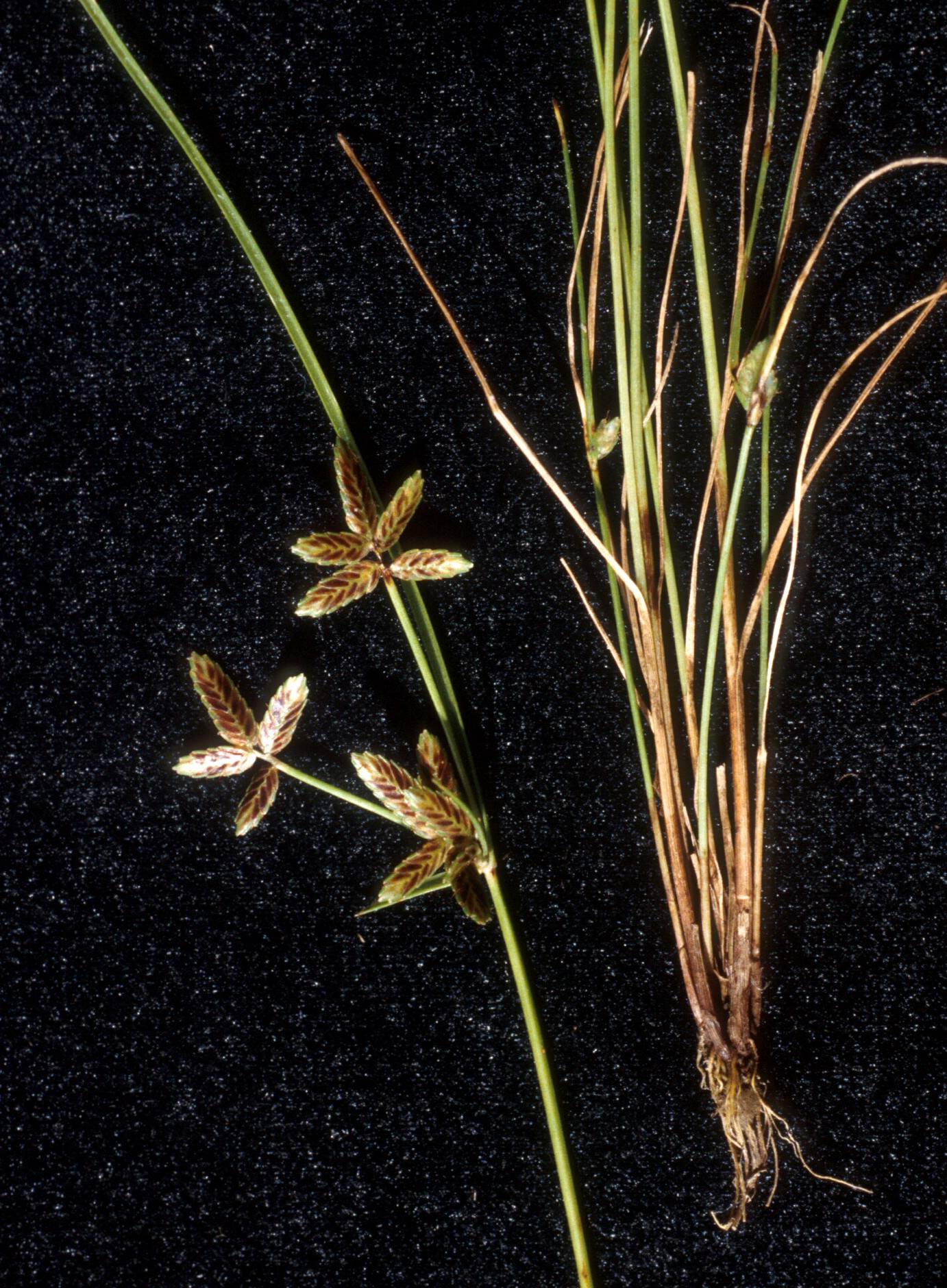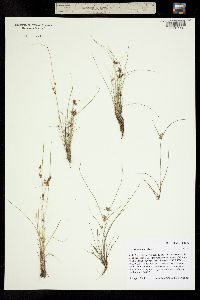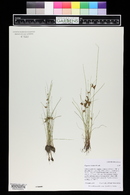|
|
|
|
Family: Cyperaceae
slender flatsedge
[Cyperus niger var. rivularis (Kunth) V.E.Grant, moreCyperus rivularis Kunth, Pycreus rivularis (Kunth) Palla] |
Herbs, annual, densely cespitose, with fibrous roots. Culms roundly trigonous, 3-25(-30) cm × 0.3-1.4 mm, glabrous. Leaves 1-3, V-shaped, 1-8 cm × 1-2 mm. Inflorescences: spike 1, loosely ovoid, compressed, 7-14 × 9-14 mm; rays 1-4, to 2(-3) cm; bracts 2-3, horizontal to ascending at 30(-45)°, V-shaped to flat, 1-12 cm × 0.5-1.5 mm. Spikelets 3-5(-8), flattened, oblong to oblong-lanceoloid, 8-18 × 2-2.6(-3) mm; floral scales (6-)10-26(-32), closely imbricate, laterally light to dark brown, medially light brown, laterally ribless, medially 2-3-ribbed, 2-keeled, oblong to ovate, 1.9-2.7 × 1.8-2.3 mm, apex obtuse. Flowers: stamens 2-3; anthers 0.4-0.5 mm, connective not prolonged; styles 0.6-1 mm; stigmas 1-1.5 mm. Achenes black, network of ridges forming isodiametric or square cells, sessile, obovoid to ovoid, 1-1.3(-1.5) × (0.6-)0.8 mm, apex apiculate, surfaces minutely punctate. Fruiting summer. Emergent shorelines, ditches, puddles, often in disturbed places; 0-1500 m; Ont., Que.; Ala., Ariz., Ark., Calif., Colo., Conn., Del., D.C., Ga., Ill., Ind., Iowa, Kans., Ky., La., Maine, Md., Mass., Mich., Minn., Miss., Mo., Nebr., Nev., N.H., N.J., N.Mex., N.Y., N.C., N.Dak., Ohio, Okla., Oreg., Pa., R.I., S.C., S.Dak., Tenn., Tex., Utah, Vt., Va., Wash., W.Va., Wis.; Mexico; Central America; South America. Annual herb with fibrous roots, densely tufted 1 - 25 cm tall Leaves: one to three, alternate, 1 - 8 cm long (usually shorter than culm), 1 - 3 mm wide, V-shaped in cross-section, linear, parallel-veined, keeled beneath, with a sheathing base that encloses the stem. Inflorescence: consisting of one or more terminal spikes, subtended by spirally arranged leafy bracts. Bracts two to three, horizontal to ascending, unequal, 1 - 12 cm long, 0.5 - 1.5 mm wide, flat or V-shaped in cross-section. Rays (branches of inflorescence) zero to five, to 2 cm long. Spikes stalked or stalkless, 7 - 14 mm long, 9 - 14 mm wide, loosely egg-shaped, compressed, consisting of three to ten spikelets. Flowers: minute, in the axil of a floral scale, lacking sepals and petals. Stamens two or three, exserted. Anthers about 0.5 mm long. Pistil one. Style to 1 mm long, two-cleft to about the middle, deciduous. Fruit: a one-seeded achene, stalkless, black, 1 - 1.5 mm long, about 0.5 mm wide, lenticular (lens-shaped) and egg-shaped or reverse egg-shaped with a small, slender point at the apex, tiny-dotted, with a network of ridges. Seed with a thin, non-adherent wall. Culm: 1 - 25 cm long, to about 1.5 mm wide, roundly triangular in cross-section, solid. Spikelets: 8 - 18 mm long, 2 - 3.5 mm wide, flattened, oblong to oblong lance-shaped, subtended by two small bracts, with ten to twenty-six floral scales. Scales spirally arranged and overlapping, becoming reddish brown, 2 - 2.5 mm long, about 2 mm wide, oblong to egg- lance-shaped with a blunt apex, two-keeled, two- to three-ribbed, lowest one empty. Similar species: No information at this time. Flowering: late July to late September Habitat and ecology: Common on muddy shores and in wet gravel or sand. Occurence in the Chicago region: native Etymology: Cyperus is the ancient Greek word for sedge. Bipartitus means two-parted. Author: The Morton Arboretum Tufted annual 1-2(-4) dm; cauline lvs 1-3 mm wide, usually shorter than the stem; spikes all sessile, or the 1-5 rays to 10 cm; spikelets 3-10, 8-15 נ2-3.5 mm; scales ovate, 2-2.5 mm, as seen from the side in half-view usually less than 3 times as long as wide, obtuse, and with the prominent midvein incurved distally to a somewhat cucullate tip, at maturity strongly red-brown from midrib to margin (less so distally), not sulcate; stamens 2(3); achenes lenticular, elliptic-obovate, 1-1.5 mm; style undivided in the basal third, deciduous. Wet ground, especially along shores; Me. and Que. to N.D., s. to Ga. and Tex. (C. niger var. castaneus; C. rivularis) Gleason, Henry A. & Cronquist, Arthur J. 1991. Manual of vascular plants of northeastern United States and adjacent Canada. lxxv + 910 pp. ©The New York Botanical Garden. All rights reserved. Used by permission. |





